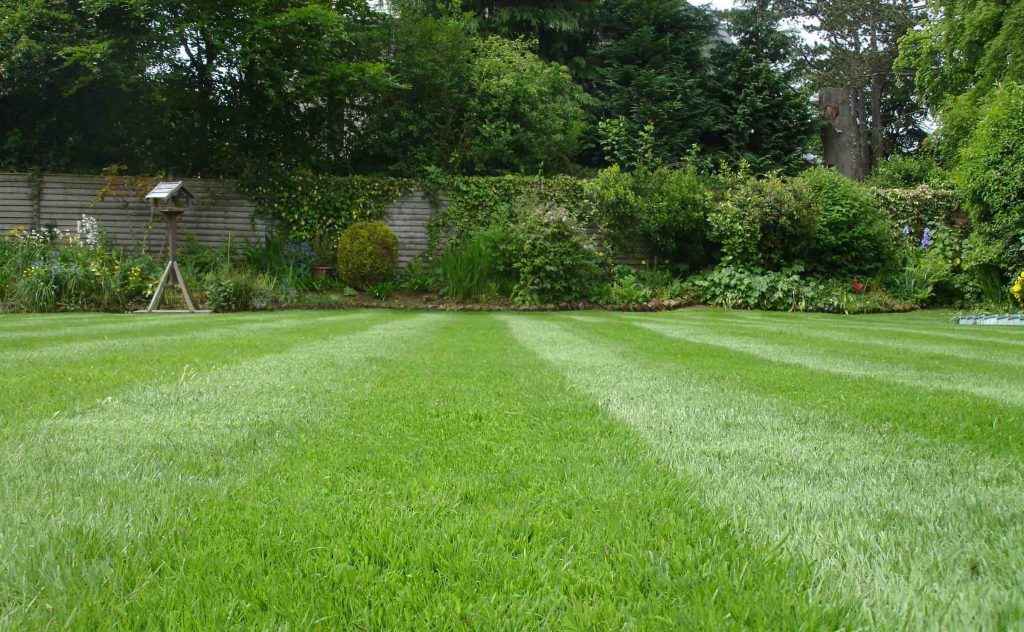I am going to explain how to mow your lawn properly.
Mowing is the most important part of lawn care and garden maintenance. But it is also the most overlooked and misunderstood.
There is much more to it than setting your mower to the lowest setting and push it around your garden.
Doing it this way causes damage that will take months to repair.
This is why we’re going to tell you how to mow the lawn the right way.
The Benefits of Mowing a Lawn Correctly
When done properly, mowing the lawn has three benefits.
A Better Looking Lawn
It creates a healthier, better-looking lawn.
Mowing is like plant pruning; it encourages new growth.
When grass plants produce new stems, shoots and leaves, a thicker, denser sward is created. Eventually, you will have a lawn that looks like a luxurious green carpet.
Less Issues with Weeds, Moss and Disease
As your lawn grows denser and thicker, it creates a barrier that weed seeds can’t get through. This makes it difficult for them to contact the soil and germinate.
It is also true of moss too; with all this grass there’s no space for it to grow in so you’ll have less need to remove it. The result is a lawn that can protect itself against lawn disease.
You’ll Save Money
Mowing properly increases the health of your lawn and lowers the risk of weeds, moss, and disease. This results in less money spent on weed killer and moss killer as well as lawn feed and fungicides.
Better for your wallet and better for the environment.

Grass Cutting Tips and Advice
Follow these simple grass cutting tips and advice and you’ll see how even a rough lawn will quickly improve in health and appearance.
Never Cut Off More Than a Third of the Grasses Length
Cutting grass too short is one of the biggest and most common mistakes gardeners make. Removing too much of its leaf takes away vital food stores which it uses in times of stress, for example during hot summer days when resources are scarce.
Grass also relies on leaves to trap sunlight used in photosynthesis and production of food; so, by not only taking away stored reserves but also blocking access to this other important resource, you’re really damaging your lawn.
To keep your lawn healthy, it is important that you keep the grass at a height of no more than two inches. If not maintained regularly, this could lead to an untidy and overgrown lawn in a few months.
The best way to know how high or low to mow is by following the rule of thirds: never cutting off more than 1/3rd from any leaf on each blade.
Never cut too short. This is even more important when cutting long grass as it can be tempted to cut it all off in one go.
Mow the Lawn Regularly and in Different Directions
With the changing seasons, you’ll need to adjust how often you mow.
During spring and autumn when your lawn is growing quickly, it should be cut at least every 7 days; if an ornamental lawn or you want a thicker sward of grass for aesthetic purposes, then once every other day is better. Change directions on a weekly basis to avoid tramlines from forming in turf which can lead weeds like Annual Meadow Grass to grow more easily. This is more important when mowing regularly.
A robot lawn mower might be a good idea if you don’t have the time or energy to maintain your lawn. They are efficient and let you control when they come out to mow by scheduling them. This can be done daily or weekly. Whatever works best with your lawn maintenance schedule.
When it comes to summer maintenance, mow at least every 10 days. Grass growth will be slowly down, but this will help keep weeds away.
In winter there is no need to cut unless growth has occurred. If it has and the weather is suitable, you can give it a cut to keep it tidy.
Avoid Mowing Wet Grass
Wet grass is dangerous, so you should avoid cutting it. Firstly, wet grass can be electrified when cut by an electric lawn mower. People have been killed because of this occurrence and slipping on moistened surfaces when using a lawn mower is also dangerous.
Wet grass will also place strain on your mower due to the extra load involved. This will wear out components and quickly drain your battery if using a cordless mower.
Mowing in the wet is bad for grass too. Mowers struggle to cut cleanly and cause tears. This can rip clumps out of your lawn and leave a mess.
Water can also cause corrosion and even contaminate fuel in petrol mowers.
Wet grass is difficult remove from mower blades and is more likely to sit on your lawn in clumps. If not removed, this can lead to lawn disease.
Mow at the Right Time of Day
There are many factors to consider when deciding the best time of day to cut your lawn, but one that is often overlooked is dew.
Mid-morning and late afternoon hours can be a good time for mowing because it allows sufficient recovery from morning dew before it sets back in later.
Early mornings should be avoided as the grass will be wet and midday should be avoided due to heat.
Mulch Grass Clippings
Some lawn mowers can mulch grass clippings. This shreds them into small pieces where they’re then blown back onto your lawn. This great because they contain water and nutrients. They decompose and break down where these nutrients are reabsorbed into the ground.
As a result, less fertiliser is required which will save you money.
You should avoid mulching if weeds and dandelions are present as these seeds will also be spread across your lawn.
Stripe Your Lawn for a Professional Look
If your lawn mower has a roller, you can stripe your lawn if you follow some basic guidelines.
If the stripes are meant to be straight, make sure they’re as straight as possible. Wavy or curvy lines which are meant to be straight look untidy.
Feel free to get creative and make a few patterns if you’re confident in your ability.
Trim the Edges of Your Lawn
If you want your lawn to look like it’s been professionally manicured, then edge the sides where it meets a fence, wall, path or planted border.
This will give a ‘finished’ appearance which will look tidy. The edges should be trimmed every 2-3 cuts with edging shears or a grass strimmer.
For more better results use either a pair of garden scissors or an edging iron or uneven edges.
Keep Your Lawn Mower Blades Sharp
Tring to mow with dull blades is another common mistake many gardeners make.
Blunt rotary mowers often fail to cut the grass at all, tearing it instead which opens grass up for disease and insect damage.
One classic sign that a blade needs sharpening is when you notice the tips of your lawn turning brown or jagged instead of straight. You can sharpen dull blades yourself with a grinder or flat file.
Alternatively, take it to your local lawnmower shop if this sounds too daunting.

Final Verdict
When it comes to how to mow the lawn correctly, there’s more to it than you might think.
But it doesn’t have to be difficult.
The two most important grass cutting advice I can give is to mow regularly and never remove more than a third of the total length during any one cut.
If you abide by these two rules, the health of your lawn will improve significantly.